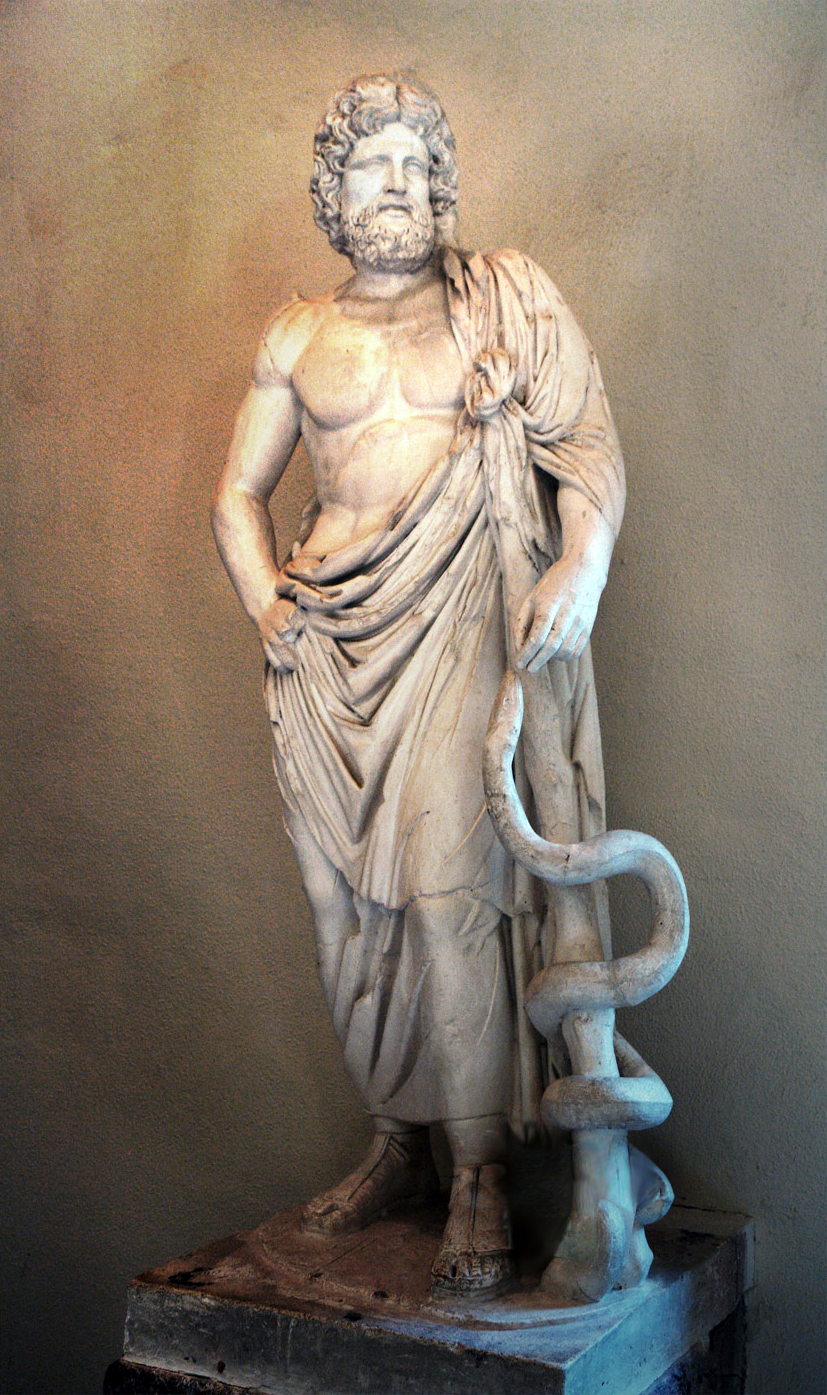It’s easy to sometimes take modern medicine for granted. We don’t have to visit an oracle or priest to diagnose an illness. Popping to a pharmacy is less messy than sacrificing a chicken to read its innards. In the UK, we currently have the NHS. Yet the ancient Greeks and Romans had Aesculapius.
But who was this god? He doesn’t appear in as many stories as Jupiter, Venus, or Neptune. He’s known as Asclepius in Greece, and Aesculapius in Rome.

Just to make things even more confusing, Aesculapius is associated with Vediovis/Vejovis, another God of healing. Vejovis is sometimes identified with Apollo…though in the Greek origin story, Apollo is Asclepius’ father.
Who needs soap operas when you have the gods?! Either way, let’s go and meet him.
Let’s go meet him!
The Inevitable Origin Story
Aesculapius is son of the god Apollo and Coronis. In some stories, she’s a nymph. Other stories say she’s a mortal woman. Myths are many things but they’re rarely consistent.
Apollo sent a white raven to her as a guardian. Instead, it passed on bad news. She’d been unfaithful while pregnant with our hero. Apollo’s twin sister Artemis, goddess of hunting, shot Coronis. So great was Artemis’s fury that the raven turned black since it brought bad news.
Artemis also removed Aesculapius while Coronis lay on a funeral pyre. Apollo gave the baby to Chiron. This mighty centaur raised him and taught him all he knew about healing.

Aesculapius and Healing
Aescalupius also discovered various cures and learned about the healing properties of plants. According to some legends, his healing prowess grew too far. He could even bring the dead back to life.
In one version of the myth, Aesculapius learned how to prevent death using his various cures. But he also learned how to resurrect the dead. This angered Zeus so he threw a thunderbolt at Aesculapius. Judith Anne Stanton explains that Zeus hated the healer for encroaching on divine territory (1999). Aesculapius blurred the line between mortals and gods.

Stephen Fry tells it a little differently in Mythos (2018). Here, Aesculapius wins the support of Athena when he heals an injured snake – one of her chosen animals. By way of thanks, she gives him a jar of Gorgon blood. Whether she knows what the blood can do or not is a moot point. Either way, Aesculapius discovers it raises the dead.
He continues healing but starts resurrecting the dead as well. Eventually, Hades goes to Zeus, bemoaning the unnatural state of affairs. Humans are supposed to live, die, and enter the underworld. They’re not supposed to live, die, and live again.
Zeus agrees that Aesculapius has overstepped the mark. He kills him with a thunderbolt, but such is the general respect for the healer, Zeus places him in the heavens. The constellation became ‘Ophiuchus’.
Ophiuchus, the Snake Bearer
Ophiuchus has caused quite the commotion recently. The inaccurate story that NASA had ‘discovered’ a 13th star sign made the rounds again.
Some think it represents Apollo wrestling the snake at Delphi. Others see the association with Aesculapius.
Is it a zodiac sign or not? Should all the signs get shunted around, forever annoying those who identify as Cancer and now have to accept they’re a Gemini?

Taurus Poniatowski, Serpentarius, Scutum Sobiesky, and Serpens, plate 12 in Urania’s Mirror, a set of celestial cards accompanied by A familiar treatise on astronomy … by Jehoshaphat Aspin (1825) Sidney Hall / Public domain
Short answer is no. Ophiuchus is a constellation. But it’s not a star sign. Trouble is, the signs of the zodiac and constallations aren’t actually the same thing (McClure 2019).
In western astrology, which uses the tropical zodiac, the path of the sun is divided into twelve segments. Each segment takes up 30° of celestial longitude (AstrologyClub 2017). These segments become the signs of the zodiac. The sun is in front of each sign for about a month (McClure 2019).
But the constellations are ‘fixed’, and they’re dependent on the stars that make them up. They’re not all the same size and they actually don’t always coincide with the zodiac signs. The sun is in front of them for different periods of time (McClure 2019). The differences are thanks to the precession of the equinoxes – check out this article by AstrologyClub who explain this better than I ever could.
The Snake Bearer is so named thanks to Aesculapius’ association with snakes.
Temples to Aesculapius
Temples to Aesculapius doubled as hospitals. Knowledge of the healing arts passed from father to son. If you wanted to be healed, you’d take a pilgrimage to the temple. Once there, you’d make sacrifices, offer prayers, and donate money. Temples were usually built near wells with healing powers, or on hills outside a town.

The sanctuary of Epidaurus was also known as the Asklepieion. It became the most important temple of healing in ancient Greece. People sought both intervention by Aesculapius himself or medicines dispensed by human priests. The site was so important that a festival of music, sport, and theatre was held there in his honour every four years (Cartwright 2013).
Other deities with the ability to heal existed in Roman mythology but many favoured Aesculapius due to his talent as a physician. So you might pray to another god to be healed, and they’d healed you if they felt like it. Aesculapius took his role more seriously and many believed he actually cared about humans.
!['A Sick Child Brought Into The Temple Of Aesculapius' by John William Waterhouse [Public Domain]](https://upload.wikimedia.org/wikipedia/commons/2/27/John_William_Waterhouse_A_Sick_Child_Brought_Into_The_Temple_Of_Aesculapius.jpg)
Not to mention the sacrifices or payments demanded by other deities. If you visited a temple to Aesculapius, you’d go to sleep and ‘dream’ his instructions. A priest interpreted whatever you dreamed and prescribed a ritual to help cure you (Cartwright 2013).
Aesculapius Goes to Rome
Plague ravaged Rome in 292 BC. They had no idea how to stop it. While ancient Greece was fascinated by medicine, in ancient Rome doctors were seen as little more than craftsmen. Jaehyun Kim explains that’s why it’s difficult to find a Roman equivalent to Aesculapius. While Jupiter has Zeus, and Minerva has Athena, they didn’t have a specific medicine-based god.

So the Romans just Latinised his name and imported him. They sent an envoy to Aesculapius’s temple in Epidaurus. He returned with a sacred snake – one of many living in the temple. It left the boat at Tiber Island so the Romans founded their first temple to Aesculapius.
For Jaehyun Kim, the ability of the Romans to “steal” Aesculapius from Greece proved Rome’s primacy in the ancient world (2013).
The Rod of Aesculapius and the Caduceus
Our hero is associated with the Rod of Aesculapius, a sceptre or staff entwined with a snake. The legends are very specific about the species of snake. It’s an Elaphe longissima. Indigenous to southern Europe and totally harmless, many lived in his temples. Snakes represented healing and rejuvenation in ancient cultures. Some people even thought they could sniff out herbs.

By contrast, the Caduceus, the winged rod, is the symbol of Mercury.
Some think the link between Mercury’s Caduceus and medicine dates to the 7th century AD. Alchemists became linked with the “hermetic arts” (Hermes is the Greek version of Mercury). When alchemy expanded to include medicine and pharmacology, people adopted the Caduceus as a medical symbol.
The Rod of Aesculapius is the better choice due to its association with actual healing. After all, the god kept medicine in the family.
Two of his daughters are Hygieia (goddess of health) and Panacea (goddess of the universal remedy). You might recognise their names! Hygieia gave her name to the word ‘hygiene’. While a panacea is a solution for all diseases and difficulties.
Here’s Aesculapius and Hygieia.

The original Hippocratic Oath started with the line, “I swear by Apollo the Physician and by Aesculapius and by Hygieia and Panacea and by all the gods…”
The God in Roman Britain
The Romans brought Aesculapius, among others (like Fortuna and Oceanus), to Britain.
According to Roman Inscriptions of Britain, seven altar stones to Aesculapius exist in Britain (2020). He shares two with Fortuna and Hygieia. They’re in Chester, Binchester, Bath, Carlisle, South Shields, and Lanchester. This is the altar at South Shields, found near Arbeia Fort’s east gate.

The transcription translates as:
To the god Aesculapius Publius Viboleius Secundus gave this altar as a gift.
Tyne & Wear Museums
It was dedicated by Secundus, and it’s possible he wanted to thank Aesculapius for a boost in his health.
Joan P. Alcock notes the popularity of Aesculapius among soldiers, which explains his presence at forts like Chester (2011: 247). Doctors also, unsurprisingly, favoured him.
When the cult of Aesculapius spread throughout the Empire, his shrines turned into spas. It’s not surprising these spas used thermal springs.
!['A Visit to Aesculapius' by Edward John Poynter (1880) [Public Domain]](https://upload.wikimedia.org/wikipedia/commons/e/e8/Edward_John_Poynter_%281836-1919%29_-_A_Visit_to_Aesculapius_-_N01586_-_National_Gallery.jpg)
That said, in Britain, you’d more likely encounter Aesculapius in one of the Roman military hospitals. One was discovered at Chester, but despite being in a military outpost, it provided care for the sick, not injured soldiers.
The tendency of his priests to prescribe diet changes or more exercise make Aesculapius a herald of today’s healthy eating culture!
Over to you! Had you heard of Aesculapius before today?
If you enjoyed this post, why not give it a share? And sign up below to get my guide to protecting your home with folklore.
References
Alcock, Joan P. (2011) A Brief History of Roman Britain: Conquest and Civilisation, London: Constable & Robinson.
AstrologyClub (2017), ‘Ophiuchus – a 13th Zodiac Sign? No!
Signs and Constellations: The Origin of the Illusory ‘Thirteenth Sign’ Debate’, AstrologyClub, http://astrologyclub.org/ophiuchus-13th-zodiac-sign-no/.
Cartwright, Mark (2013), ‘Aesculapius’, Ancient History Encyclopedia, https://www.ancient.eu/Asclepius/.
Fry, Stephen (2018), Mythos: The Greek Myths Retold, London: Penguin.
Kim, Jaehyun (2013), ‘A Healing God Comes to Rome: Aesculapius and the Effects of the Arrival of His Cult’, Dissertation submission, Baylor University, https://baylor-ir.tdl.org/bitstream/handle/2104/8611/jaehyun_kim_honorsthesis.pdf?sequence=1.
McClure, Bruce (2019), ‘Ophiuchus, 13th constellation of zodiac’, EarthSky, https://earthsky.org/sky-archive/ophiuchus-highest-on-august-evenings-2.
Roman Inscriptions of Britain (2020), ‘RIB 1052. Altar dedicated to Aesculapius’, Roman Inscriptions of Britain, https://romaninscriptionsofbritain.org/inscriptions/1052.
Stanton, Judith Anne (1999), ‘Aesculapius: A Modern Tale’, JAMA Network, https://jamanetwork.com/journals/jama/fullarticle/1839796.
Nutty about folklore and want more?
Add your email below and get these posts in your inbox every week.
You'll also get my 5-step guide to protecting your home using folklore!







 Buy me a coffee on Ko-fi
Buy me a coffee on Ko-fi

I love the research you oput into your post.
It’s my favourite part
There are wrong informantions though. It is not Artemis, but Apollo who turns the Raven black, and removes Asclepius from Koronis’ womb.
This article was misleading to me.
I’m happy to update articles but could you tell me what your source for that information is? I did plenty of research and my sources all said it was Artemis.